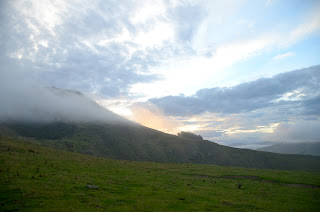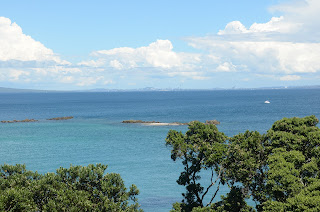*For those interested,
I will provide a history of Tiritiri Matangi first. If you are just interested
in pictures, scroll down.
It is one thing to manufacture a close encounter at a zoo.
(And that is not to diminish meeting a red kangaroo, red panda, and a trio of
lemurs – moments I will remember and cherish for the rest of my life.) It is
quite another matter to come face to face with animals in the wild.
Tiritiri Matangi is a special place with a history that
encapsulates everything New Zealand values as a country keenly concerned with
conservation. Like many other small offshore islands, Tiritiri was converted
from lush forest to rolling farmland by European settlers. As recently as forty
years ago, the island you see below resembled one giant, grassy hill; in an
aerial photograph featured in the island brochure, one is hard pressed to even
find a single tree.
The replanting began in the 1980s; a core team of dedicated
volunteers frequented the island, bringing seeds with them. Any group that was
interested in lending a hand – sports teams, businesses, community
organizations – joined the effort to generate a new forest.
The result is breathtaking and astounding. More importantly,
it is now a sanctuary for endangered birds endemic to New Zealand. Some have
been translocated; others have been returned to a tiny plot of land that was
once rightfully theirs. This is an ongoing movement in the country: the mammals
cannot possibly be eradicated from the mainland, so massive operations are
undertaken to clear offshore islands of pests (rats, stoats, etc.) so that
birds can flourish freely.
 |
| Tiritiri Matangi today |
The volunteers at Tiritiri are inspiring. At least a dozen
joined the group visiting today, (a single boat goes to the island five times a
week, bringing no more than 150 visitors at a time) and they are the reason
Tiritiri exists at all: they funded and built the trails, they run the visitors
center and gift shop, and they do just about every other task needed to
maintain the welfare of the island. They are also experts in local ornithology.
That being said, as soon as I saw groups being divided for
optional guided tours, I chose to explore the island for myself. I came to
Tiritiri to photograph the wildlife, and the birds were not going to pose as
calmly with bunches of ten gathering and gawking.
An amazing decision. I developed bird watching skills on the
go, and I am guessing that they were not conventional. I relied on my ears,
yes, but the key was not always looking up. Many of the birds hop around on the
ground just a few feet away, and others are flightless. Moreover, the shadows
of shaking branches and birds flying above were easy to detect on the ground.
The rewards were plentiful. Rarely did five minutes pass
without a bird sighting. More often than not, they were only a few feet away,
hanging in a nearby branch or bouncing around on the ground. It was like going
to the aviary at the zoo, but in the wild and so much better.
The highlights are below. I will provide a brief caption for
each, but I do want to add one last more extensive note about three of the
pictures. For those of you who read my article before I left, the Takahe has a
special place in my heart. It is also one of the rarest bids in the world, and
four live on Tiritiri. Today, I met all of them.
An interesting family history. Greg is 19 years old, well
exceeding his life expectancy, and now wears a tracker around his body so the
park ranger always knows his whereabouts. He is a pesky fellow who is unafraid
of humans, but he now spends his time by the shoreline alone. His mate abandoned him recently for a
younger male, and the new pair have violently attacked Greg numerous times.
They now live, with their chick, by the lighthouse on top of the island. It’s a
sad story for Greg, but ultimately important that the gene pool is diversified.
Fortunately, I had the honor of meeting Greg. Here are the
three Takahe picture I would like to share.
Here are North Island Robins; they are extremely tiny, and
will not hesitate coming close to humans while hopping around on the ground.
The first shot I took when one was sitting right next to me. The other was on a
nearby branch.
This is a Bellbird. They essentially initiated me into
Tiritiri Matangi. I encountered a group of about a dozen, all together and singing
at a high volume. Many were within arm’s reach; they were the most common and
uninhibited birds I saw today.
These are Tui. When they mature, they grow a patch if white
feathers beneath their bill.
This is a Saddleback, named for the red on its back. I
caught this one eating berries in a treetop.
These are Oyster Catchers along the shoreline.
This is a New Zealand Pigeon. It’s impossible to tell from
the picture but they are huge; nothing like a city pigeon. Their size makes it
difficult to fly, and one often hears their struggles to go airborne before
seeing their impressive colors.
Here are some scenic shots. In the first one, you will see
Auckland along the horizon.
Just had a White Lady burger as my final meal in Auckland. The first half of my trip is officially over. Off to South Island tomorrow!
No blog tomorrow night as I will be on a boat in the Milford Sound. That just means more pictures on Saturday...your Friday. Kia ora until then everyone!





















































